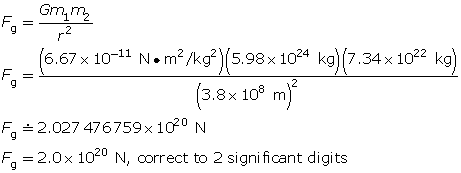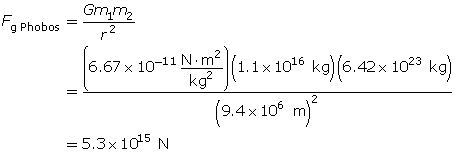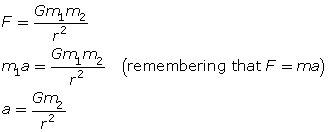Module 4—Gravitational Force
Conclusion
The weight of the satellite at this altitude is 98.0 N, which is one-fourth of the weight at Earth's surface (392.2 N). An explanation for this reduction by a factor of 4 follows.

Apply Newton's law of universal gravitation. Find the magnitude of the force exerted by Earth on the satellite (i.e., the satellite's weight). This weight is inversely proportional to the square of the distance between Earth and the satellite. The distance has to be taken from the centre of Earth, not from the surface.

When the satellite is moved from Earth's surface (6378 km) to a point one Earth radius above Earth's surface (2 × 6378 km), the distance from Earth's centre is doubled.

In Newton's universal law of gravitation, the distance (r) is squared and this means the force is only ¼ as large.
Why do you have to use the distance from the centre of Earth, not from the surface?
Newton's law of universal gravitation makes a statement about the forces that two point-sized masses exert on each other. Since Earth certainly is not point-sized, you must calculate the force that this extended object exerts on a satellite. That is, you must sum all gravitational forces that the individual infinitesimal parts of the Earth exert on the satellite.
Another of Newton's accomplishments, calculus, can be used to simplify the calculation. You would likely make the assumptions that Earth is a perfect sphere and that its mass is distributed uniformly inside of it. Having made these assumptions, the result from calculus is remarkably simple. Earth acts like a point-sized particle with all of its mass at its centre.
Newton's law of universal gravitation is also useful for determining the force of attraction between any two masses. Consider the force that keeps the Moon in orbit. For example, using the data table below, calculate the force of attraction between the Moon and Earth.
| mass of Earth = 5.98 × 1024 kg | mass of the Moon = 7.34 × 1022 kg |
| mean lunar orbit = 3.8 × 108 m |

This very large force keeps the Moon in its orbit!
 Module 4: Lesson 2 Assignment
Module 4: Lesson 2 Assignment
Remember to submit the answer to TR 1 to your teacher as part of your Module 4: Lesson 2 Assignment.
 Try This
Try This
TR 1. Determine the gravitational force of attraction between a small cargo ship (5.00 × 104 kg) and a supertanker (1.50 × 106 kg) that is 500 m away. Compare your answer to the force of attraction between Earth and the Moon. Why are gravitational forces between masses on Earth so small?
 Read
Read
Read “Newton’s Law of Universal Gravitation” on pages 203 and 204 of the physics textbook to see a way of calculating the gravitational force.
 Self-Check
Self-Check
SC 3. Complete the “Concept Check” question on page 205 of the textbook.
 Self-Check Answers
Self-Check Answers
SC 3.
(a) The magnitude of the gravitational force increases. It becomes 4 times the original force.
(b) The magnitude of the gravitational force increases. It becomes 4 times the original force.
(c) The magnitude of the gravitational force decreases. It becomes 1/16 of the original force.
 Read
Read
Read “Using Proportionalities to Solve Gravitation Problems” on pages 207 and 208 of the physics textbook to see how the concepts from the previous reading and question are applied.
 Self-Check
Self-Check
SC 4. Complete “Practice Problem” on page 208 of the textbook.
 Self-Check Answers
Self-Check Answers
SC 4.
(a) If the separation distance increases to 4/3 of its original value, the magnitude of the gravitational force will change by a factor of (3/4)2 or become 9/16 of its original value. If the mA increases to 3/2 of its original value, the magnitude of the gravitational force will become 3/2 of its original value. If the mB decreases to 1/2 of its original value, the magnitude of the gravitational force will become 1/2 of its original value. The net effect of all three changes is that the gravitational force will become (5.9 × 10–11 N)(9/16)(3/2)(1/2) or 2.5 × 10–11 N.
(b) If the separation distance decreases to 1/6 of its original value, the magnitude of the gravitational force will change by a factor of (6)2 or become 36 times its original value. If the mA decreases to 1/2 of its original value, the magnitude of the gravitational force will become 1/2 of its original value. If the mB increases to 5/4 of its original value, the magnitude of the gravitational force will become 5/4 of its original value. The net effect of all three changes is that the gravitational force will become (5.9 × 10–11 N)(36)(1/2)( 5/4) or 1.3 × 10–9 N.
 Read
Read
What happens when two widely separated objects both exert a gravitational pull on a third object? Read “Using Superposition to Find the Net Gravitational Force on an Object” on pages 208 to 210 of the physics textbook.
 Self-Check
Self-Check
SC 5. Complete question 5 of “4.2 Check and Reflect” on page 215 of the textbook. This is not a superposition question, although it has similarities.
 Self-Check Answers
Self-Check Answers
SC 5.
(a) Phobos will exert a greater gravitational force on Mars because Phobos is closer to Mars and has a larger mass.
(b)


Applying the Law of Universal Gravitation to Determine Acceleration
If you have closed the Weight and Orbits simulation, reopen it to complete the following questions.
 Self-Check
Self-Check
SC 6. What happens to the magnitude of the acceleration as the satellite is moved farther away from Earth? Investigate this by turning on the acceleration vector by clicking the “Vectors” button (![]() ) and selecting acceleration and deselecting velocity. Then click off the “Vectors” button. Set the scale setting to 100 pix = 10 000 km. Observe how the acceleration vector changes by dragging the satellite to various positions around Earth.
) and selecting acceleration and deselecting velocity. Then click off the “Vectors” button. Set the scale setting to 100 pix = 10 000 km. Observe how the acceleration vector changes by dragging the satellite to various positions around Earth.
What do you notice about the magnitude and direction of the acceleration vector?
SC 7. On the simulation, set the scale setting to 100 pix = 10 km. This is the most magnified setting. The satellite will be outside of the bounds of the window. Set x = 0 km and y = 0 km to move the satellite back to the North Pole. Now drag the satellite around the display area, and observe the changes in the magnitude of the acceleration vector. Are the changes in magnitude large or small near Earth's surface?
 Self-Check Answers
Self-Check Answers
SC 6. The acceleration vector has greater magnitude close to Earth and rapidly decreases in magnitude as it is moved away. It always points toward the centre of Earth.
SC 7. You should find that there is very little change in magnitude and no noticeable change in the direction of the acceleration. How do you explain this? At this scale setting, the distance changes that are possible within the window are just tiny fractions of the radius of Earth. For a significant change in the acceleration to occur, the distance from Earth’s surface must change by an amount comparable to the radius of Earth.
You can derive a general expression for the magnitude of the acceleration (a) acting on a satellite of mass (m1). Use Newton's second law (F = ma) and the law of universal gravitation (![]() ). You’ll also need Earth’s mass, m2, and the distance (r) of the satellite from the centre of Earth.
). You’ll also need Earth’s mass, m2, and the distance (r) of the satellite from the centre of Earth.

Using this equation, it is possible to determine the local value for the acceleration due to gravity at any point relative to a large mass, such as a comet, moon, planet, or star.